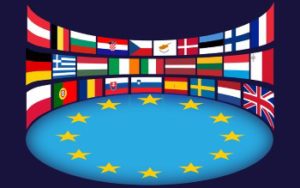EUR/GBP Currency Pair
Of all of the popular currency pairs traded on the Forex market, the EUR/GBP currency pair has a very strong position. The Euro and British Pound have low volatility, and this offers several benefits due to their stability. As a pair, EUR/GBP is the eighth most popular choice for Forex trading, and it is quoted according to its supply and demand to four decimal places. This currency pair can also be quoted either way around, and therefore it may be represented as GBP/EUR and sometimes as EUR/GBP depending on the broker. The EUR/GBP pair is known as a trending pair, characterised by frequent long periods of falling or rising trends with little fluctuation in the intermediate periods. Investors should therefore use traditional trading methods to invest in this pairing, which has historically always moved within a channel of 0.5673 to 0.9800. The central bank relating to the Euro is the ECB, and the central bank relating to GBP is the Bank of England, or BoE. Paying close attention to data and economic releases from both of these institutions is key to successful trading of the EUR/GBP pair.
| Broker | Bonus | More |
|---|
Facts About the GBP
The central bank of the United Kingdom is the Bank of England (BoE). The British Pound, or Pound Sterling, is the fourth most-traded currency in the world, and also the globe’s fourth most-held reserve currency. The Pound has a number of colloquial names, including the Quid, the Nicker and the Cable. The Pound holds the distinction of being the oldest currency that is still in use today, and is one of the most frequently converted currencies, with Saint Helena, Gibraltar and the Falkland Islands all being pegged to the GBP. The GBP dates back to 760, when the
silver penny was introduced to the Anglo Saxon kingdom. By 1158 its design had been changed to one that was no longer formed from pure silver, and it was at that time that its name was changed to the Sterling Pound. In 1487 the shilling was introduced, and then the Pound arrived in 1489. Paper notes became currency in 1694, and their legal basis was changed from silver to gold. In 1695, just one year later, the Bank of England was established as one of the world’s first central banks. In the early part of the 20th century, an increasing number of countries started to tie their currency to gold, and thus a gold standard was formed to allow conversion between the currencies of various countries, which brought a revolution in the international trading economy. The gold standard was officially adopted in Britain in 1816, and this led to a major period of economic growth in the country, which lasted until the start of the First World War. The British Pound was also circulated in the British Empire’s colonies, which led to it being held by many banks as a reserve currency. However, when the British economy went into decline the US Dollar took over. By 1971 the Sterling Area had been terminated, and following that time, the Pound went through several periods of highs and lows.
The Eurozone and the Euro
The European Union (EU) is overall the biggest economic region on the globe, with a GDP of more than $113 trillion. Just like the United States, the economy of the European Union has a strong focus on the services industry, but a difference remains in the large percentage of the EU’s GDP that relates to manufacturing when compared to that of America. At times of strong EU economic activity, the Euro will naturally increase in strength; and conversely, in times of EU economic slowdown, the Euro shows a weakening. There is one thing that makes the Euro unique when compared with the other major currencies trading in the Forex market, and that is the fact that it represents the currency of multiple countries rather than just a single nation. The Euro has been adopted as the one currency for the entire European and Economic Monetary Union, or EMU as it is better known, which is made up of 16 different European nations. Another name for this collective group of countries is the Eurozone. As can be expected when several countries make up one union, there are occasional disagreements between governments over issues such as monetary policy and economic direction. During these times, a weakening in the value of the Euro can often be observed. The 16 countries that make up the Eurozone at the present time are
- Austria
- Cyprus
- Belgium
- France
- Finland
- Greece
- Germany
- Luxembourg
- Italy
- Republic of Ireland
- The Netherlands
- Malta
- Slovakia
- Portugal
- Slovenia
- Spain
Factors That Have an Affect on the GBP/EUR Pair
There are several factors that can affect the GBP to EUR currency pairing. These include the following:
Similar to most other Forex currency pairs, the EUR/GBP pairing is extremely sensitive to several external factors, and economic data announcements have a major influence upon the short-term rate. This means that traders who want to achieve the best possible success in the market should check their daily economic calendar, and especially between the hours of 10 am and 11 am for news about the GBP, and before 2:30 pm to find information about the Eurozone.
Investors should check the GDP of both the UK and the Eurozone as well as capital input and withdrawal, new monetary policies, inflation, and any economic or political happenings that could affect the opinions of investors, causing them to either sell or buy positions.
It is also key to bear in mind the exchange rate of both the Pound Sterling and the Euro with other worldwide currencies. For example, if either the Euro or Sterling has lost ground against the US Dollar, their competitiveness for export increases, which will lead to a new rising trend.




